Letters from Lodi
An insightful and objective look at viticulture and winemaking from the Lodi
Appellation and the growers and vintners behind these crafts. Told from the
perspective of multi-award winning wine journalist, Randy Caparoso.
Ode to Lodi's legendary Flame Tokay, never to be forgotten
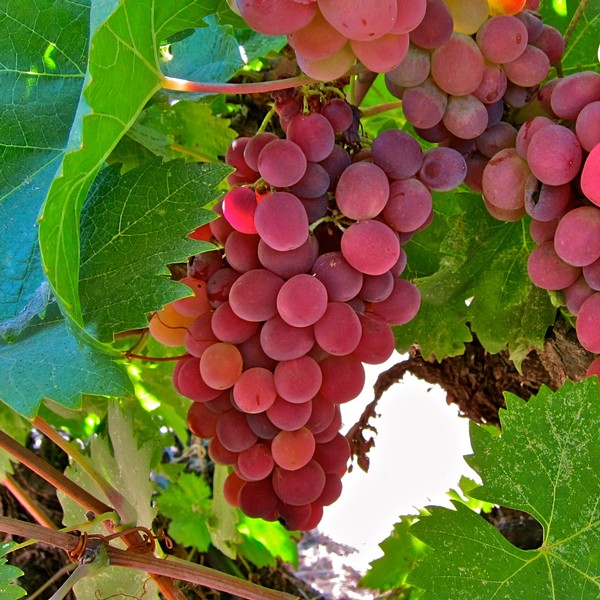
Flame Tokay—a.k.a., Ahmeur bou Ahmeur—on own-rooted Mokelumne River-Lodi grapevine over 130 years old,
About eight miles east of the City of Lodi, there is a short country lane called Tokay Colony Road, demarcated by Hwy. 88 to the west and N. Tully Rd. at its eastern end. It's an interesting road because it was named for the grape variety called Tokay—more properly known by its full name, Flame Tokay—which for about 100 years was the most widely planted grape in the Lodi wine appellation.
Only, it was never really a wine grape. Flame Tokay was primarily a table grape, grown for the fresh market, in supply for no more than a month's time each year.
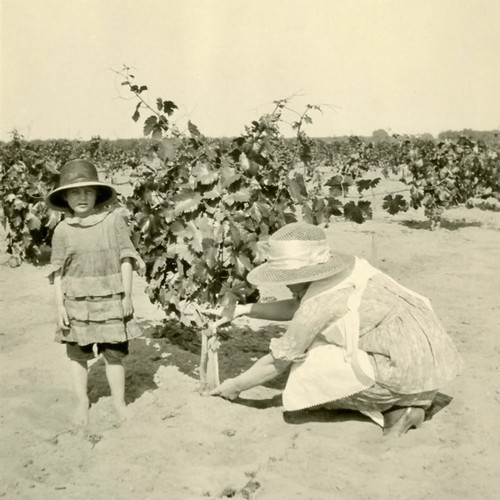
1922 photo of Flame Tokay cultivated in the extremely sandy, fine-grained alluvium of Lodi's Mokelumne River region in J.C. Kakel Ranch. UC Merced Cooperative Extension Archive.
Flame Tokay was always very much a "Lodi thing." It was possible to cultivate this variety outside of Lodi, but happenstance, or terroir, was such that it was only in Lodi that farmers were able to consistently achieve the "flaming" pinkish red color which made these hefty clusters so popular as an eating grape.
The crop was so profitable, in fact, that the City of Lodi, which was incorporated by its citizens in 1906, literally owed its early wealth and identity primarily to this one agricultural product. Lodi, in the early 1900s, proudly billed itself as the "Tokay Capital of the World."
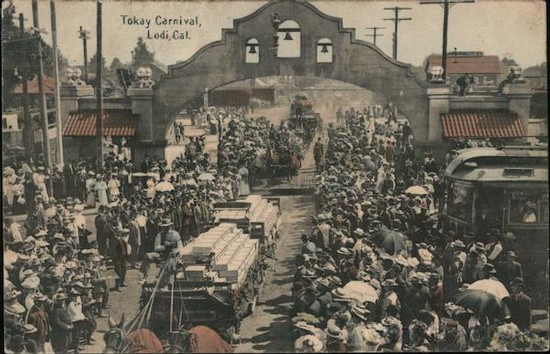
1907 postcard commemorating Lodi's Tokay Carnival, depicting part of the mile-long procession of horse drawn carts laden with just-picked Flame Tokay grapes entering the city through the landmark Mission Arch.
The lost Tokay Colony
The funny thing about Tokay Colony Road is that you can drive along its entire length (a little less than 3 miles), lined by 5-to-12-acre lots, and not find a single planting of Flame Tokay vines.
But the locale did, in fact, start off as a community called Tokay Colony, to specialize in Flame Tokay grapes. It was founded in 1908 by three farmers of Norwegian descent who were inspired by the widely acclaimed Tokay Carnival, a three-day event organized by the newly minted City of Lodi in 1907.
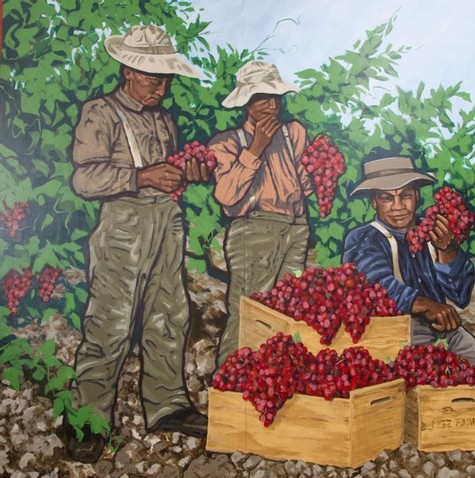
Asian grape pickers, who once lugged Lodi-grown Flame Tokay grapes in wooden boxes weighing over 50 pounds apiece. San Joaquin County Historical Museum.
According to Ralph Lea and Christi Kennedy, who authored a story published by Lodi News-Sentinel on March 3, 2006 (see Tokay Colony began in 1908 as a farming community), "In 1908, people in Lodi were steadfastly proud of their new progressive city and the region's great agricultural promise."
Hence, the inspiration for Tokay Colony. Writes Lea and Kennedy, "Riding Lodi's wave of self-promotion, [Tokay Colony founders] Houge, Topson and Nordwicke got together and subdivided their farmland into five-acre plots. They sold the land parcels with the understanding that the new owners would plant Tokay grapes. The region would be known as Tokay Colony."
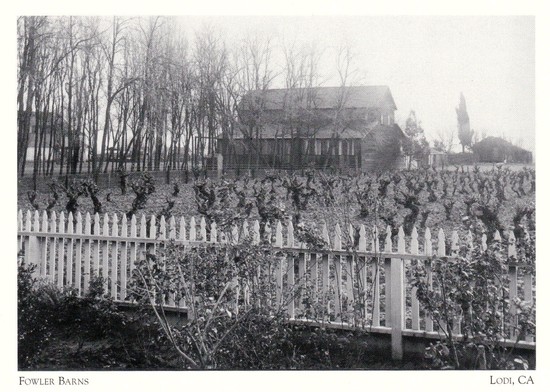
1907 postcard of Lodi ranch showing head trained Flame Tokay vines, already of advanced age.
By 1909, there were enough families buying into the concept to warrant the establishment of the Tokay Colony School District. A one-story schoolhouse was constructed near the corner of Jack Tone and Live Oak roads, housing two classrooms and an auditorium. In 1917, a Tokay Colony Methodist Church was built for the Norwegian Methodist Church; and by 1935, a total of 50 families populated the colony.
Alas, while the farm lots envisioned by the founders were enough for small chicken ranches, vegetable gardens, and a few hogs and heads of cattle, the soil type along Tokay Colony Road proved too shallow to successfully ripen the Flame Tokay grapes for which the colony was originally conceived.
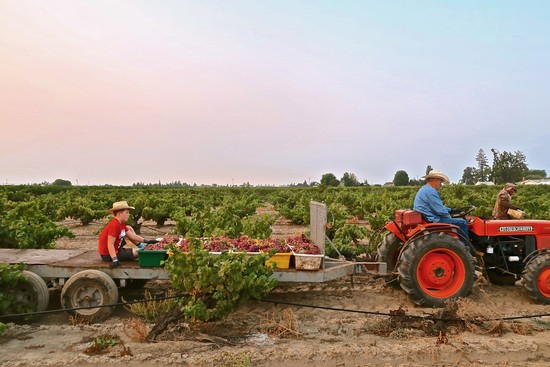
Recent harvest of Old School Vineyard, a 1906 Flame Tokay block certified by Historic Vineyard Society, sitting on a deep pocket of ultra-sandy alluvial soil near the banks of the Mokelumne River in which this Mediterranean grape variety absolutely thrives.
Writes Lea and Kennedy: "The heavier soil in the Tokay Colony area produced larger crops, but the grapes stayed green longer. Since they didn't get enough color to be sold profitably as table grapes, the Tokay Colony grapes were usually sold to wineries for a lesser price and crushed into wine or brandy.
"Even though the region did not develop into a thriving village of Tokay grape growers as the Norwegian farmers envisioned, many families enjoyed their lives on small farms in the country"—which they still do, to this day.
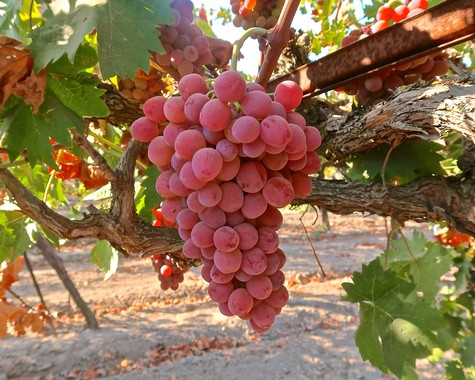
Picture-perfect cluster of Flame Tokay growing in the middle of a block of trellised Cabernet Sauvignon owned by Phillips Farms, in the south section of Lodi's Mokelumne River AVA.
Nearly gone but not completely forgotten
Today, we do not talk about Flame Tokay because it is an important commercial product. It hasn't been, for over 40 years.
We still talk about Flame Tokay because it remains emblematic of the Lodi wine region. It is its history in Lodi that defines what makes this appellation unique and special with respect to natural attributes. It explains, in fact, exactly why Lodi is by far the largest winegrowing region in all of California, thus the entire United States.
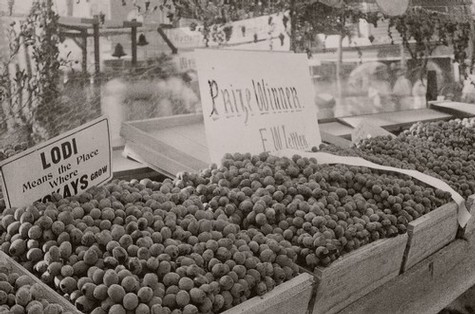
Award-winning crates of Flame Tokay on display during Lodi's 1907 Tokay Carnival.
Simply put, grapes grow extremely well in Lodi, and it all started with the success of Flame Tokay.
Despite the grape's long and prosperous history in the Lodi AVA, there is no Wikipedia page on Flame Tokay. There is, however, a Wikipedia reference to the fact that Tokay can be a synonym for the Hungarian grape Furmint. Furmint is used to produce the legendary wines of Hungary's Tokaji region, but there is no relation between the Flame Tokay of Lodi and the Furmint of Hungary.
In its wisdom, UC Davis' Foundation Plant Services does have a page listing clonal selections of Flame Tokay, while acknowledging its identity as a cultivar of Vitis vinifera (i.e., belonging to the classic European family of wine grapes), probably originally known as Ahmeur bou Ahmeur.
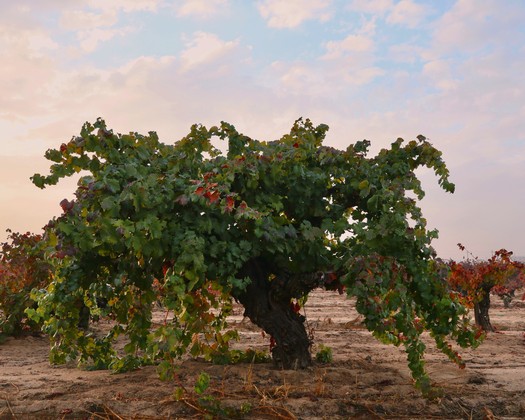
The massive tree-like scale of Flame Tokay at nearly 100 years of age (this specimen, dates back to the mid-1920s), often in blocks planted mostly to Zinfandel, on the east side of Lodi's Mokelumne River appellation.
There are, in fact, numerous synonyms used for Flame Tokay around the world, cited by Foundation Plant Services; including Ahmeur bou Ahmeur, Ahnour bou Ahmou, Amar bou Amar, Angelina, Angelino, Argenlina, Boal Babosa, Bourdji, Brick, Casta de Ragol, Casta tinta, Codego, Cognac, Culo de Horza, Culo de Orza, Datilidos, Encarnada de Ragol, Flame Coloured Tokay, Fondo de Orza, Grumete Encarnada, Hamri, Imperial negra, Imperial roja, Kabylia, Lombardy, Olho de Pargo, Ragol, Ragol roja, Raisin del Bordj, Rhenish, Roja de Ragol, Rouge fils de Rouge, Royal Gordo, San Geromina, San Jeronimo, Tokay, Uva de Colgar, Uva de Ragol, and Vlamkleur Tokai
The European wine marketing platform called wein.plus contends that Ahmeur bou Ahmeur originated in the Mediterranean Basin wine region of Algeria, in North Africa; describing the cultivar as "only moderately sensitive to drought... suitable for hot regions."
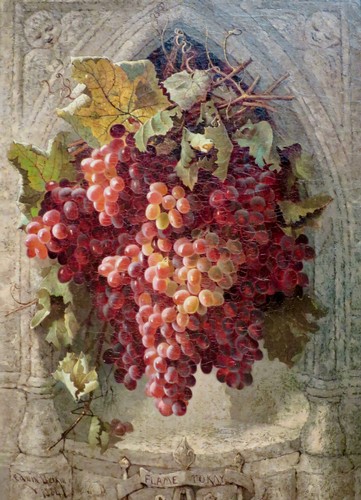
1884 illustration of Flame Tokay by Edwin Deakin, reprinted in East Coast nursery catalogs circulated during the late 1800s.
True to its apparent origins, when Flame Tokay was first introduced to California—most likely during the 1850s, arriving among the dozens of other European cultivars brought in from East Coast nurseries—the grape took to the state's dry summer, warm climate regions like fish to water, but it was in Lodi where it was found to be most easily adapted.
A summary of the plant's history in California:
• In 1857, a crop identified as Flame Tokay was planted by James Rutter in the Florin area of Sacramento County (just north of the present-day boundaries of Lodi's Sloughhouse AVA)—to the best of everyone's knowledge, the first significant planting of this grape.
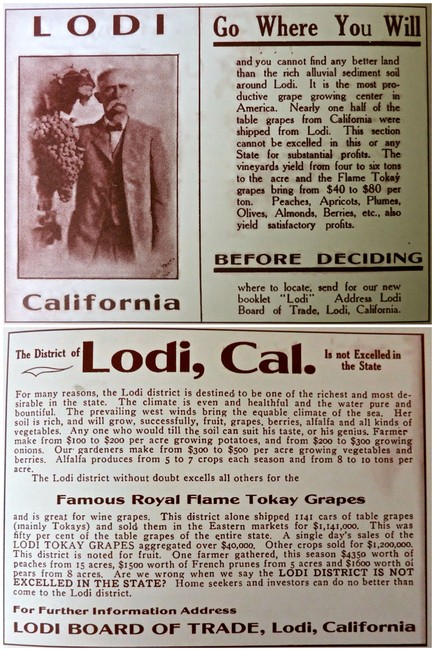
Lodi Board of Trade ads, circa 1907, proclaiming all the reasons "the Lodi district is destined to be one of the richest and most desirable in the state"—primarily because of the success of Flame Tokay farming.
• While Sacramento County farmers successfully sold Flame Tokay in San Francisco fresh markets, the grape was quickly embraced by growers in the Lodi area (in neighboring San Joaquin County), who discovered that the cultivar could more easily attain its reddish-pink "flame" color in the far deeper, sandier alluvial soils surrounding the community known as Mokelumne (changed to Lodi in 1874).
• In 1861, it was noted that Flame Tokay was among the 20 different grape varieties planted in the Lodi area by George Perley.
• In 1864, George Leffler went on record as planting 6 acres of Flame Tokay, in the vicinity of today's Eight Mile Road, between Lodi and Stockton.
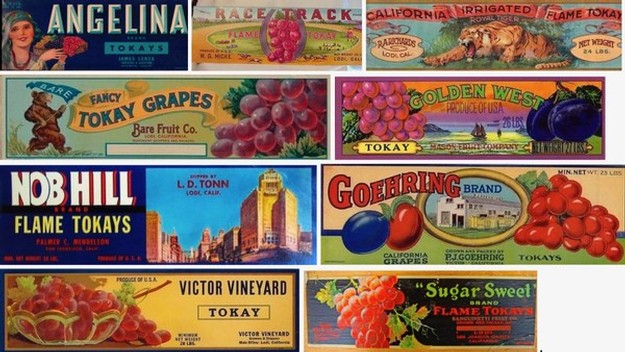
Vintage crate labels harken back to the days when Lodi-grown Flame Tokay was shipped by railroad to markets near and far.
• Starting in 1886 on his square-mile farm in the Woodbridge area (just west of Lodi), Joseph Spenker planted substantial blocks of Flame Tokay alongside other grape varieties (most notably Cinsaut, Zinfandel, Black Prince, and Carignan) found to be suitable to the rich sandy loam soils near the banks of the Mokelumne River.
• In 1907, to celebrate and publicize the wealth brought to the region by the grape, the City of Lodi held a three-day festival called the Tokay Carnival (September 19-21), presided over by a duly elected "Queen Zinfandel" and a court of 10 ladies in waiting. On the first day, the Tokay Carnival opened with a mile-long procession of horse-drawn carts teeming with Flame Tokay grapes. At 8:00 PM on the final night, the Queen "abdicated" her throne to a "King Tokay" who ordered all watches and clocks set back 6 hours and the arrest of anyone found partying on the streets without a mask.
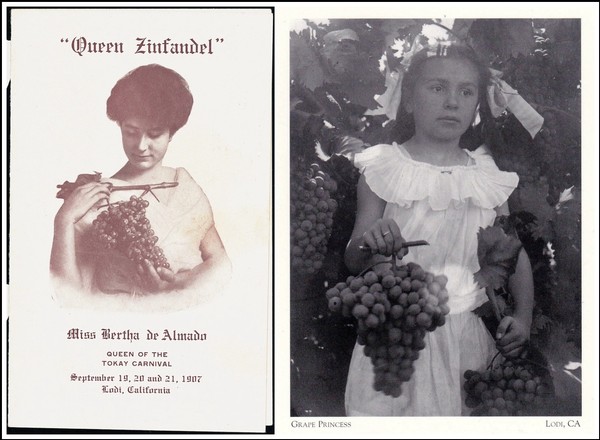
Two postcards commemorating Lodi's 1907 Tokay Carnival: "Queen Zinfandel" and a "Grape Princess," both laden with Flame Tokay, emblematic of the wealth and beauty of Lodi.
• In 1934, three-day yearly celebrations, this time called the Lodi Grape Festival, were started back up again, still inspired by Flame Tokay. While the grape is no longer a commercially viable crop, the Lodi Grape Festival is still celebrated today.
• In 1973, a Flame Seedless (Sultana x Cardinal) grape crossing was developed in Fresno; one of many varieties of seedless table grapes bred to thrive in warmer climate regions in South Central Valley, spelling the beginning of the end of the nearly century-long dominance of Flame Tokay in the Lodi region and economy.
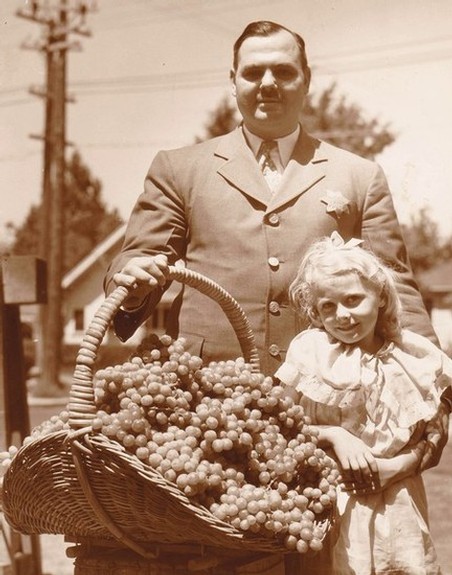
1934 publicity photo for the Lodi Grape Festival depicting Police Chief Clarence Jackson, who spearheaded the revival of the yearly celebration, with his daughter and a basket of the symbol of Lodi, Flame Tokay grapes.
Sister grapes
By the 1980s, the introduction of hybridized seedless grapes drove seeded varieties such as Flame Tokay completely out of the fruit market. Fortuitously, the 1980s was also the era of rapid expansion of California wine production. A time when industry leaders such as Robert Mondavi were encouraging Lodi growers to plant more of the grapes needed by wineries, such as Cabernet Sauvignon, Chardonnay, Merlot, Sauvignon blanc, and (for about a decade) Chenin blanc. In Lodi, thousands of acres of Flame Tokay were replaced by these major wine grapes.
Among wine grapes, Zinfandel had always been Lodi's leading variety, starting in the late 1800s, and it remained that way during the 1980s because of the White Zinfandel craze. Long before the popularity of White Zinfandel, however, Zinfandel was widely planted in Lodi for the same reason why Flame Tokay was planted: Because both cultivars were the most easily adapted to the region's warm, dry Mediterranean climate and deep, rich sandy loam soils, thus proving to be the most profitable.
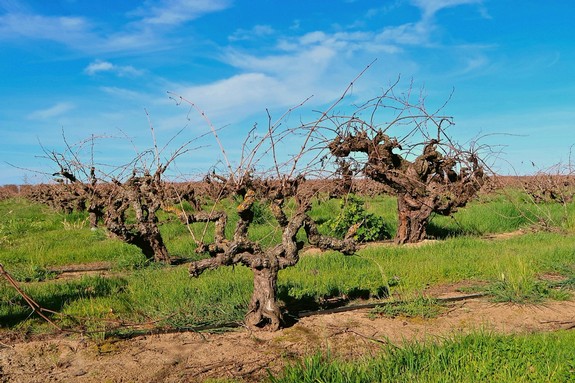
Gigantic Flame Tokay alongside relatively diminutive Zinfandel plants in Viola's Vineyard, a Clements Hills-Lodi block planted in 1948, now certified by Historic Vineyard Society.
In fact, Tokay Series is the official name of the soil classification defining the 85,700-acre sub-appellation surrounding the City of Lodi, called Mokelumne River. It is the specific soil type in which both Flame Tokay and Zinfandel thrive the most.
Lodi still produces approximately 40% of all the Zinfandel in California—besides being the home of the country's largest stand of old vines (i.e., vineyards planted between the 1800s and 1960s)—for precisely this reason. It is all about terroir.
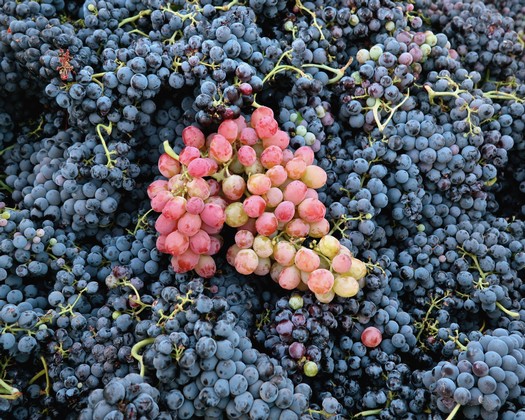
Recent harvest of ancient vine Zinfandel in a Mokelumne River-Lodi block interplanted with Flame Tokay.
In that sense, the two grapes, Zinfandel and Flame Tokay, were always considered sister grapes. Lodi was the king of Flame Tokay because you couldn’t successfully grow the grape anywhere else in California. You could go a few miles to the north where the soil transitions from a deep sandy loam to a shallow clay loam or a few miles south further away from the moderating influence of the breezes coming off the California Delta, and you couldn't get Flame Tokay to turn its vivid pink color (at least on a consistent basis) even if you tried.
Same with Zinfandel. Sure, it was possible to grow good Zinfandel outside the Mokelumne River AVA—in, say, Lodi's Jahant or Clements Hills AVAs, both defined by shallower, gravelly clay soils. But it has only been in the areas that are close enough to the banks of the Mokelumne River, where there are enough deposits of sandy alluvium for grapevines to set the deep root systems necessary for grapevine health, that Zinfandel has been productive in terms of quality and yield.
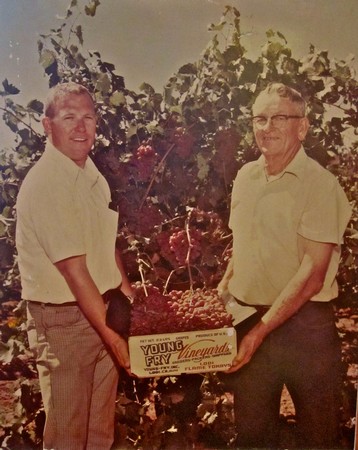
Late 1960s photo of Jerry Fry (left), during an era when Flame Tokay was still a major part (along with Zinfandel) of Mohr-Fry Ranches operations.
It was Flame Tokay, in fact, that taught some of Lodi's most successful wine grape growers how to farm Zinfandel. According to Jerry Fry, the CEO of Mohr-Fry Ranches: “In a lot of ways, growing Tokay taught us how to grow Zinfandel and other wine grapes. We thinned shoots and pulled leaves to knock out leafhoppers, in order to concentrate the color and flavor of our Tokay. So it only made sense to take care of our Zinfandel the same way."
At Jessie's Grove on Lodi's west side, a tiny stand of Flame Tokay is still maintained and goes into a lightly sweet white Port-style wine. Nearby, giant-sized Flame Tokay plants in amongst a block dominated by Zinfandel, dating back to the late 1880s, also go into varietal bottlings of Zinfandel as part of a field crush/blend, bottled by both Jessie's Grove (as "Royal Tee") and Marchelle Wines.
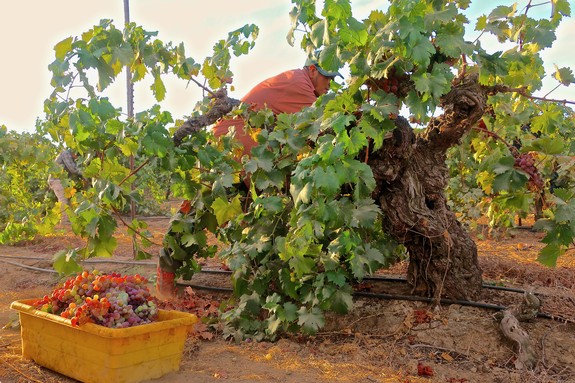
Recent harvest of Flame Tokay in Jessie's Grove's Royal Tee Vineyard, originally planted on the west side of Mokelumne River-Lodi in 1889.
There are still some scattered plants of ancient Flame Tokay, hanging on for dear life, primarily for nostalgic reasons, as either neglected or well-tended bushes in front of old Lodi homes. Regardless, still put out vividly colored fruit from gigantic, gnarly, majestically thick tree-like trunks.
There is one 4-acre block of well-cultivated 1906 vines on Lodi's east side now registered by the Historic Vineyard Society as Old School Vineyard, all going into a brandy program recently started by Delta Artisan.
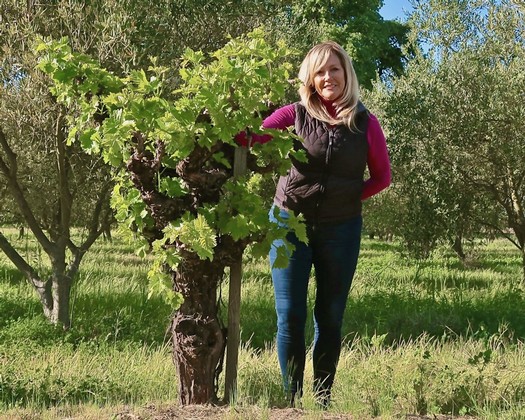
Karen Chandler in her block of Flame Tokay originally planted in the 1890s with younger Mission olive trees.
On the west side of Lodi is a 3-acre block of Flame Tokay originally planted by Zella Hansen during the 1890s, now called Chandler Vineyard (acquired by Karen Chandler in 2005). Alas, almost half of Chandler's vines, planted on 10 by 10-foot rows, were torn out in the early 2000s and interplanted with Mission olive trees by an over-zealous, since-departed partner, who was itching to get into the olive oil business. In recent years, these noble-looking vines have occasionally gone into interesting dry table wines bottled as Flame Tokay.
In an October 2010 Lodi News-Sentinel article harkening back to the good ol' days of Flame Tokay, Ms. Chandler was quoted to say: “I’ll never pull the vines out, not as long as I own the property... It’s hard to let that go, no matter if we could put another crop in there and make a ton of money."
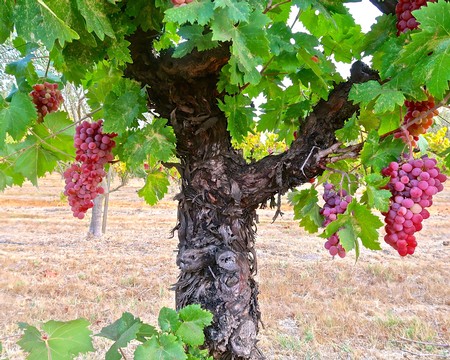
Flame Tokay clusters at a peak of their flaming pink color and flavor in Chandler Vineyard, on the west side of Lodi's Mokelumne River appellation.
Chandler hopes that her vines may soon be adopted by a school as part of a "future farmers" project, but as of yet she has not been successful in that endeavor. All the same, she remains committed to her Flame Tokay vines, well over 130 years old.
"It’s all about that tradition, and I don’t want to let it die!” says Chandler.
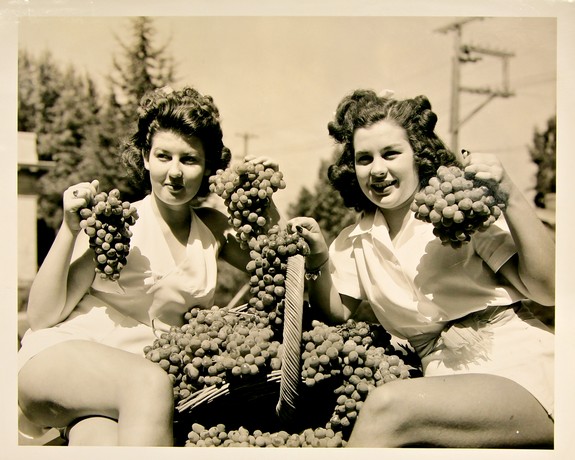
1941 Lodi Grape Festival princesses showing off—what else?—the crown jewels of Lodi agriculture, Flame Tokay.